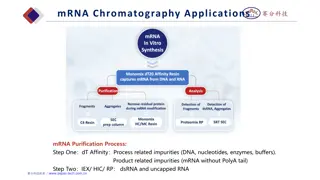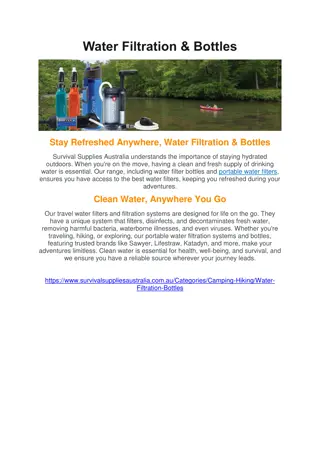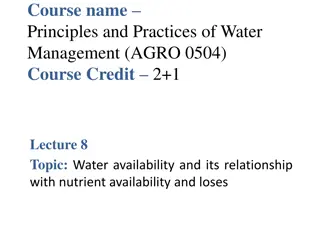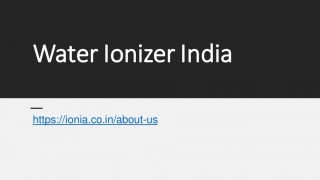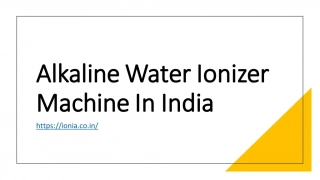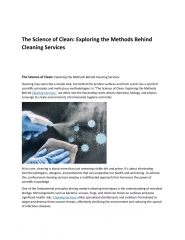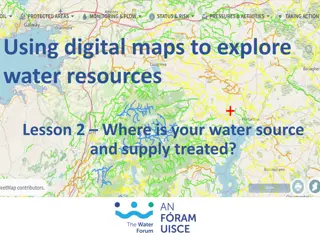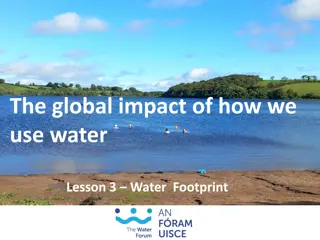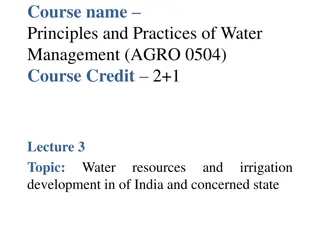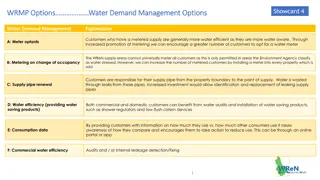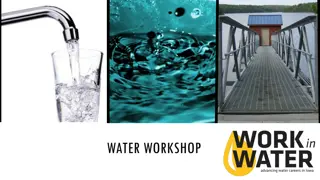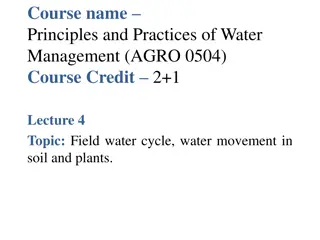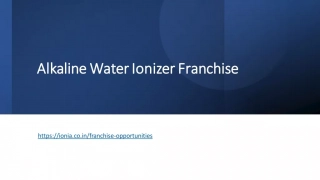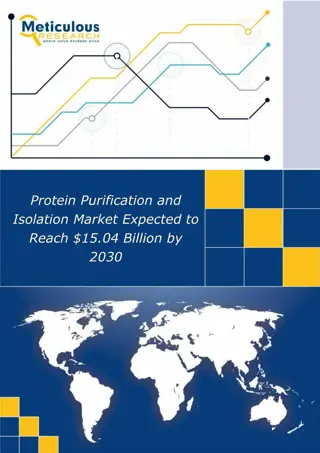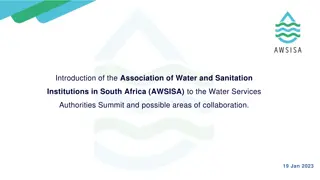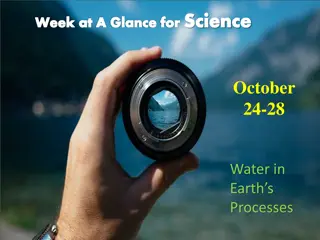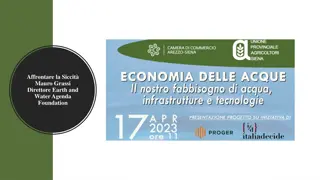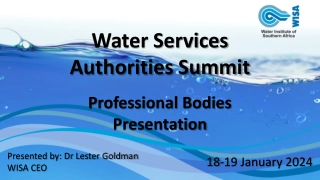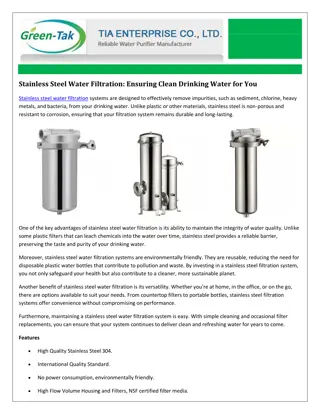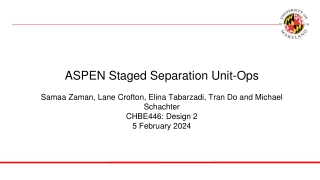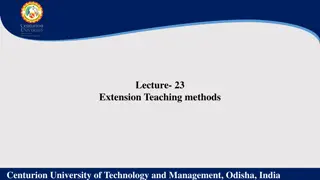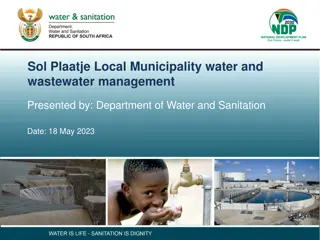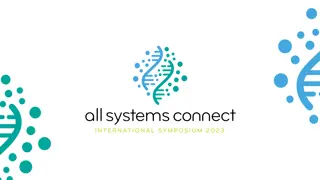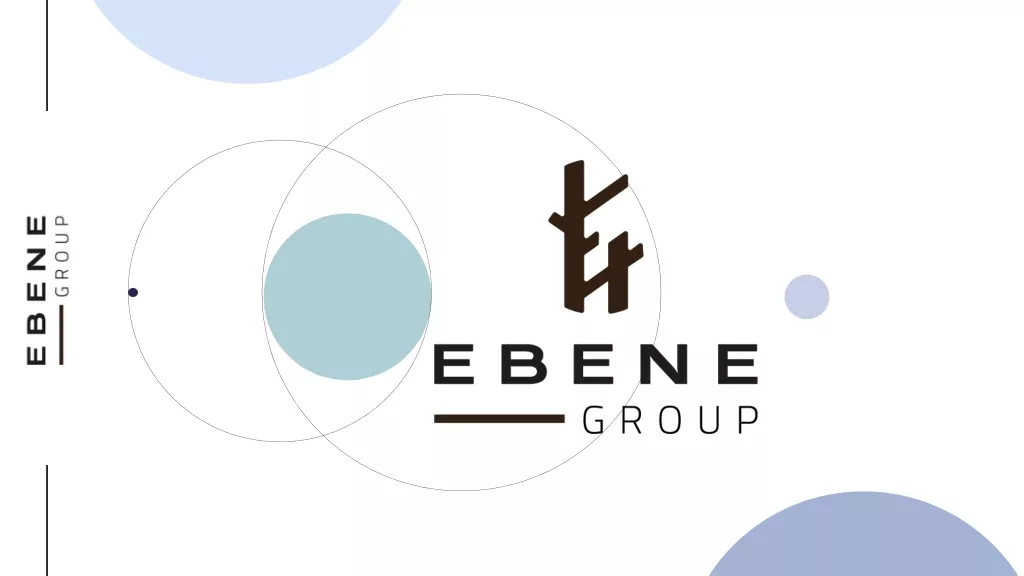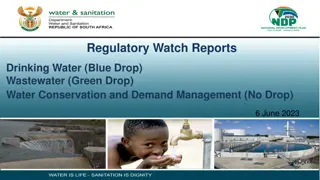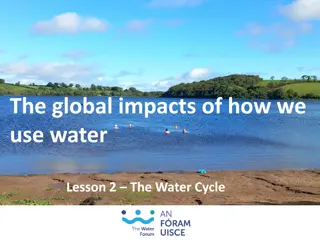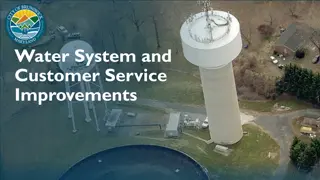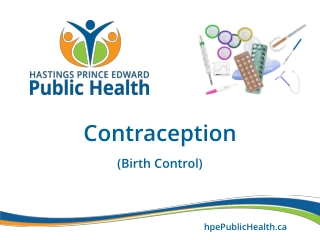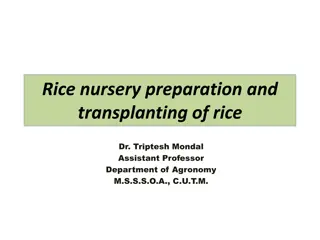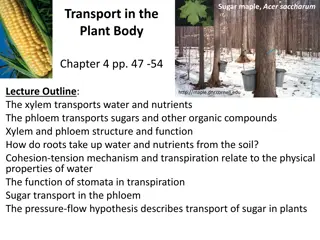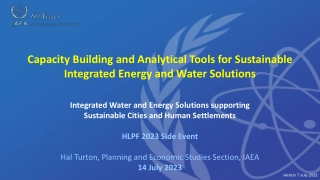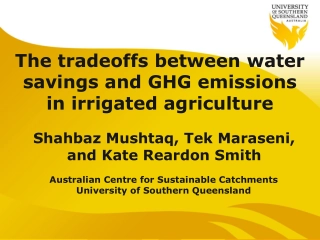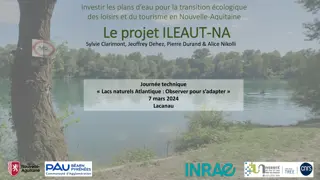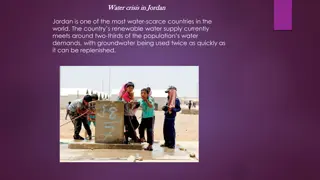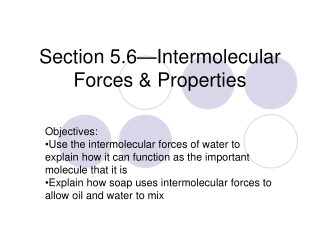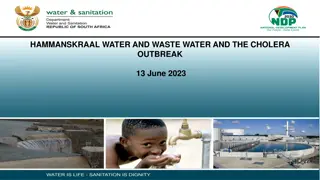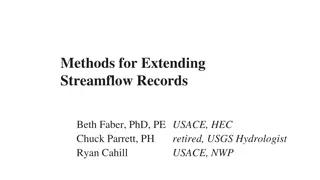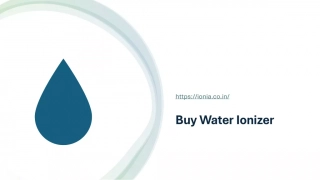Water Purification Methods and Techniques Explained
Explore the purification of water on both large and small scales, including storage, filtration, and disinfection processes. Learn about different methods such as boiling, chemical disinfection, and filtration for household water purification. Discover the importance of treatment based on the nature of raw water and desired water quality standards.
- Water purification
- Filtration methods
- Disinfection techniques
- Large scale treatment
- Small scale purification
Water Purification Methods and Techniques Explained
PowerPoint presentation about 'Water Purification Methods and Techniques Explained'. This presentation describes the topic on Explore the purification of water on both large and small scales, including storage, filtration, and disinfection processes. Learn about different methods such as boiling, chemical disinfection, and filtration for household water purification. Discover the importance of treatment based on the nature of raw water and desired water quality standards.. Download this presentation absolutely free.
Presentation Transcript
Purification of Water Presenter- DR.BHAGWAT KENDRE
CONTENTS Types Purification of water on a large scale Storage Filtration Types of filters 1. Biological or slow sand filters - Elements of a slow sand filter 2. Rapid sand or mechanical filters - Steps in rapid sand filters Disinfection - Action of chlorine - Principles of chlorination - Method of chlorination
Purification of water on a small scale (1) Household purification of water Methods A) Boiling B) Chemical disinfection C) Filtration (2) Disinfection of Wells Steps in well disinfection The double pot method Conclusion References
Types 1. Purification of water on a large scale 2. Purification of water on a small scale
1. Purification of water on a large scale Introduction The purpose of water treatment is to produce water that is safe and wholesome. The method of treatment depends upon the nature of raw water, and the desired standards of water quality. For example, ground water (e.g., wells and springs) may need no treatment,other than disinfection. Surface water (e.g., river water) which tends to be turbid and polluted requires extensive treatment.
The components of a typical water purification system comprise one or more of the following measures: I. Storage II. Filtration III. Disinfection
I. Storage Storage provides a reserve of water from which further pollution is excluded. As a result of storage, a very considerable amount of purification takes place. This is natural purification.
(a) Physical: About 90 per cent of the suspended impurities settle down in 24 hours by gravity. The water becomes clearer. This allows penetration of light, and reduces the work of the filters.
(b) Chemical: The aerobic bacteria oxidize the organic matter present in the water with the aid of dissolved oxygen. The content of free ammonia is reduced and a rise in nitrates occurs.
(c) Biological: The pathogenic organisms gradually die out. It is found that when river water is stored the total bacterial count drops by as much as 90 per cent in the first 5-7 days. The optimum period of storage of river water is to be about 10-14 days. If the water is stored for long periods, there is development of vegetable growths such as algae which impart a bad smell and colour to water.
(II) FILTRATION Filtration is the second stage in the purification of water. It is an important stage because 98-99 per cent of the bacteria are removed by filtration.
Types of filters Biological or slow sand filters Rapid sand or mechanical filters
SLOW SAND OR BIOLOGICAL FILTERS Slow sand filters were first used for water treatment in 1804 in Scotland and subsequently in London. During the 19thcentury their use spread throughout the world. Even today, they are generally accepted as the standard method of water purification.
Elements of a slow sand filter these consist of: (1) Supernatant (raw) water (2) A bed of graded sand (3) An under-drainage system; and (4) A system of filter control valves
(1) Supernatant water The supernatant water above the sand bed, whose depth varies from 1 to 1.5 metre. It provides a constant head of water so as to overcome the resistance of the filter bed and thereby promote the downward flow of water through the sand bed. It provides waiting period of some hours for the raw water to undergo partial purification by sedimentation, oxidation and particle agglomeration.
(2) Sand bed The most important part of the filter is the sand bed. The thickness of the sand bed is about 1 metre. The sand grains are carefully chosen so that they are rounded and have an "effective diameter" between 0.2 and 0.3 mm. The sand should be clean and free from clay and organic matter. The sand bed is supported by a layer of graded gravel 30- 40 cm deep.
Vital layer The surface of the sand bed covered with a slimy growth known as vital layer, zoogleal layer or biological layer. This layer is slimy and gelatinous. It consists of threadlike algae and numerous forms of life including plankton, diatoms and bacteria. The formation of vital layer is known as "ripening" of the filter.
It may take several days for the vital layer to form fully, and when fully formed it extends for 2 to 3 cm into the top portion of the sand bed. The vital layer is the "heart" of the slow sand filter. It removes organic matter, holds back bacteria and oxidizes ammoniacal nitrogen into nitrates and helps in bacteria-free water. Until the vital layer is fully formed, the first few days filtrate is usually run to waste.
(3) Under -drainage system At the bottom of the filter bed is the under-drainage system. It consists of porous or perforated pipes which serve as- - providing an outlet for filtered water, - supporting the filter medium above. Once the filter bed has been placed, the under-drainage system cannot be seen.
Filter box: The first 3 elements (e.g. supernatant water, sand bed and under- drainage system) are contained in the filter box. The filter box is an open box. It usually rectangular in shape, from 2.5 to 4 metres deep. It is built wholly or partly below ground. The walls may be made of stone, brick or cement.
The filter box consists from top to bottom : Supernatant water .. 1 to 1.5 metre Sand bed 1.2 metre Gravel support .. 0.30 metre Filter bottom .. 0.16 metre
(4) Filter control The purpose of these devices is to maintain a constant rate of filtration. An important component of the regulation system is the "Venturi meter" which measures the bed resistance or "loss of head". When the resistance builds up, the operator opens the regulating valve so as to maintain a steady rate of filtration.
Filter cleaning: Normally the filter may run for weeks or even months without cleaning. When the bed resistance increases to such an extent that the regulating valve has to be kept fully open, it is time to clean the filter bed. At this stage, the supernatant water is drained off, and the sand bed is cleaned by "scraping" off the top portion of the sand layer.
The advantages of a slow sand filter are: (1) simple to construct and operate (2) the cost of construction is cheaper than that of rapid sand filters (3) the physical, chemical and bacteriological quality of filtered water is very high. (4) When working ideally, slow sand filters have been shown to reduce total bacterial counts by 99.9 to 99.99 per cent and E. coli by 99 to 99.9 per cent.
RAPID SAND OR MECHANICAL FILTERS In 1885, the first rapid sand filters were installed in the USA. Types Gravity type (e.g. Paterson's filter) and Pressure type (e.g. Candy s filter).
Steps : Coagulation Rapid mixing Flocculation Sedimentation Filtration
(1) Coagulation: The raw water is first treated with a chemical coagulant such as alum. The dose of which varies from 5-40 mg or more per litre, depending upon the turbidity and colour, temperature and the pH value of the water.
(2) Rapid mixing: The treated water is then subjected violent agitation in a "mixing chamber" for a few minutes. This allows a quick and thorough dissemination of alum throughout the bulk of the water, which is very necessary.
(3) Flocculation: The next phase involves a slow and gentle stirring of the treated water in a "flocculation chamber" for about 30 minutes. The mechanical type of flocculator is the most widely used. It consists of a number of paddles which rotate at 2 to 4 rpm.
(4) Sedimentation: The coagulated water is led into sedimentation tanks. It is detained for periods varying from 2-6 hours when the flocculent precipitate together with impurities and bacteria settle down in the tank. At least 95 per cent of the flocculent precipitate needs to be removed before the water is admitted into the rapid sand filters. The precipitate or sludge which settles at the bottom is removed from time to time without disturbing the operation of the tank.
(5) Filtration: The partly clarified water is now subjected to rapid sand filtration. Filter beds Each unit of Filter bed has a surface of about 80 to 90 m2. Sand is the filtering medium. The effective size" of the sand particles is between 0.4-0.7 mm. The depth of the sand bed is usually about 1 metre (2 to 3 Feet).
Below the sand bed is a layer of graded gravel, 30 to 40 cm. (1-1 feet) deep. The gravel supports the sand bed and permits the filtered water to move freely towards the under-drains. The depth of the water on the top of the sand bed is 1.0 to 1 .5 m (5-6 feet). The under-drains at the bottom of the filter beds collect the filtered water. The rate of filtration is 5-15 m3/m2/hour.
Back-washing Rapid sand filters need frequent washing daily or weekly, depending upon the loss of head. Washing is accomplished by reversing the flow of water through the sand bed, which is called "back-washing". Back-washing dislodges the impurities and cleans up the sand bed. The washing is stopped when clear sand is visible and the wash water is sufficiently clear. The whole process of washing takes about 15 minutes. In some rapid sand filters, compressed air is used as part of the back washing processes.
Advantages (1) rapid sand filter can deal with raw water directly. No preliminary storage is needed (2) the filter beds occupy less space (3) filtration is rapid, 40-50 times that of a slow sand filter (4) the washing of the filter is easy (5) there is more flexibility in operation.
(III) DISINFECTION CHLORINATION Chlorination is one of the greatest advances in water purification. It is supplement, not a substitute to sand filtration. Chlorine kills pathogenic bacteria, but is has no effect on spores and certain viruses (e.g., polio, viral hepatitis) except in high doses. Apart from its germicidal effect, chlorine has several important secondary properties in water treatment : it oxidizes iron, manganese and hydrogen sulphide; it destroys some taste and odour-producing constituents; it controls algae and slime organisms; and aids coagulation.
Action of chlorine: When chlorine is added to water, there is formation of hydrochloric and hypochlorous acids. The hydrochloric acid is neutralized by the alkalinity of the water. The hypochlorous acid ionizes to form hydrogen ions and hypochlorite ions, as follows :- H2O + Cl2 HCI + HOCI HOCI H + OCl
The disinfecting action of chlorine is mainly due to the hypochlorous acid, and to a small extent due to the hypochlorite ions. The hypochlorous acid is the most effective form of chlorine for water disinfection. It is more effective (70-80 times) than the hypochlorite ion. Chlorine acts best as a disinfectant when the pH of water is around 7.
Principles of chlorination: Chlorinated water should be clear and free from turbidity. Chlorine demand of the water should be estimated. The presence of free residual chlorine for a contact period of at least one hour is essential to kill bacteria and viruses. The minimum recommended concentration of free chlorine is 0.5 mg/L for one hour. The sum of the chlorine demand of the specific water plus the free residual chlorine of 0.5 mg/L constitutes the correct dose of chlorine to be applied.
METHOD OF CHLORINATION Chlorine is applied either as (1) chlorine gas (2) chloramine or (3) perchloron
Chlorine gas It is the first choice, because it is cheap, quick in action, efficient and easy to apply. chlorine gas is an irritant to the eyes and poisonous.
Chloramines Chloramines are loose compounds of chlorine and ammonia. They have a less tendency to produce chlorinous tastes and give a more persistent type of residual chlorine. The greatest drawback of chloramines is that they have a slower action than chlorine and therefore they are not being used to any great extent in water treatment. Perchloron Perchloron or high test hypochlorite (H.T.H.) is a calcium compound which carries 60-70 per cent of available chlorine.
SUPERCHLORINATION Superchlorination followed by dechlorination comprises the addition of large doses of chlorine to the water, and removal of excess of chlorine after disinfection, this method is applicable to heavily polluted waters.
Orthotolidine (OT) Test Orthotolidine test enables both free and combined chlorine in water to be determined with speed and accuracy. The test was developed in 1918. Ozonation Ozone is a powerful oxidant and has many uses in water treatment, including oxidation of organic chemicals. It can be used as a primary disinfectant.
Membrane processes It is of most significance in water treatment are reverse osmosis, ultrafiltration, microfiltration and nanofiltration. These processes have traditionally been applied to the production of water for industrial or pharmaceutical applications, but are now being applied to the treatment of drinking water.
2. Purification of water on a small scale (1) Household purification of water Three methods are generally available for purifying water on an individual or domestic scale. These methods can be used single or in combination. A) Boiling B) Chemical disinfection C) Filtration
(a) BOILING Boiling is a satisfactory method of purifying water for household purposes. To be effective water must be brought to a "rolling boil" for 10 to 20 minutes. It kills all bacteria, spores, cysts and ova and yields sterilized water. Boiling also removes temporary hardness by driving off carbon dioxide and precipitating the calcium carbonate. The taste of water is altered, but this is harmless.
(b) CHEMICAL DISINFECTION (1) Bleaching powder (2) Chlorine solution (3) High test hypochlorite (4) Chlorine tablets (5) Iodine (6) Potassium permanganate
(1) Bleaching powder: Bleaching powder or chlorinated lime (CaOCl2) is a white amorphous powder with a pungent smell of chlorine. When freshly made, it contains about 33 percent of "available chlorine". It is an unstable compound. On exposure to air, light and moisture, it rapidly loses its chlorine content. But when mixed with excess of lime, it retains its strength; this is called "stabilized bleach." Bleaching powder should be stored in a dark, cool, dry place in a closed container that is resistant to corrosion.
(2) Chlorine solution: Chlorine solution may be prepared from bleaching powder. If 4 kg of bleaching powder with 25 per cent available chlorine is mixed with 20 litres of water, It will give a 5 per cent solution of chlorine. Ready-made Chlorine solutions in different strengths are also available in the market. Like bleaching powder, the chlorine solution is subject to losses on exposure to light or on prolonged storage. The solution should be kept in a dark, cool and dry place in a container.
(3) High test hypochlorite: High test hypochlorite (HTH) or perchloron is a calcium compound which contains 60 to 70 per cent available chlorine. It is more stable than bleaching powder and deteriorates much less on storage. Solutions prepared from HTH are also used for water disinfection


